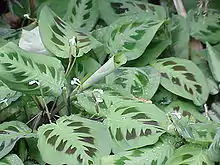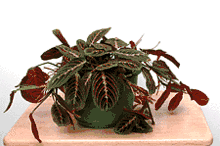Maranta leuconeura
Maranta leuconeura, also known as prayer plant, is a species of flowering plant in the family Marantaceae, native to the Brazilian tropical forests.[1] It is a variable, rhizomatous perennial, growing to 30 cm (12 in) tall and broad, with crowded clumps of evergreen, strikingly-marked oval leaves, each up to 12 cm (5 in) long.
| Prayer plant | |
|---|---|
 | |
| Foliage and flowers of Maranta leuconeura var. kerchoveana | |
| Scientific classification | |
| Kingdom: | Plantae |
| Clade: | Tracheophytes |
| Clade: | Angiosperms |
| Clade: | Monocots |
| Clade: | Commelinids |
| Order: | Zingiberales |
| Family: | Marantaceae |
| Genus: | Maranta |
| Species: | M. leuconeura |
| Binomial name | |
| Maranta leuconeura | |
| Synonyms[1] | |
| |
Description
The specific epithet leuconeura means "white-veined", referring to the leaves.[2] The leaves have a habit of lying flat during the day, and folding in an erect position at night as if in prayer for evening vespers,[3] hence the common name "prayer plant".[4][5] This behaviour is an example of a diurnal rhythm.
Small, white flowers appear during the growing season, although this is rarely observed in houseplants and the flowers are not of particular value in comparison to the attractive foliage.[6] The broad leaves of the plant are oval, two-color, greenish and fairly shiny. There are spots on both sides of the leaf medium, the color of which varies depending on the variety. The spots may be light green, green, brownish or dark gray. Medium color also varies by variety. The undersides of the leaves are variable, ranging from a light green, common in M. leuconeura var. kerchoveana, to a deep red, common in M. leuconeura var. erythroneura. Roots are shallow.[7]
Cultivation

Maranta leuconeura is a well-known houseplant in temperate regions, requiring a minimum temperature of 15 °C (59 °F). As a plant that is native to rainforests, Maranta prefers bright indirect sunlight, high humidity, and well-drained soil that has a high humus content.[6] Acidic, clay or loam soils are tolerable.[8]
Direct sunlight should be avoided, as well as standing water. At daytime the ideal temperature is 21–27°C and at night 16–21°C; the night temperature should not be lower than 15°C. Higher temperatures also require higher humidity, for example, just spraying.
During the growing season, spring and summer, Maranta houseplants require moist soil and fertilization every month. Slightly drier soils and reduced fertilizer application are recommended for the remainder of the year.[6] In warmer climates, at USDA Zones 10b-11,[8] it can be grown as groundcover in moist, shady areas.
Propagation
Spacing between plants should be between 60–90 cm (24–36 in)[8] Propagation is achieved via division and cuttings.[6] Cuttings, 10 cm in length with 3–4 leaves, should be taken in the spring. Bottom heat can be applied to the cuttings to promote rooting.[7] Propagation by seed is possible although is less common. Seed germination is recommended at 13–18 °C (55–64 °F).[7] Maranta leuconeura can also be propagated in vitro.[9]
Varieties
The following naturally occurring varieties (distinguishable from artificially selected cultivars) have gained the Royal Horticultural Society's Award of Garden Merit:-[10]
Common uses
M. leuconeura can be grown in planters, hanging baskets, mass planting, and as an edging plant.[8] This plant is frequently used in shopping malls.[8]
Chemistry
Rosmarinic acid can be found in plants in the family Marantaceae such as Maranta leuconeura.[13]
Diseases
Maranta usually experiences minimal insect pest pressure, however, spider mites and mealybugs can be of concern.[6] Leaf spot and cucumber mosaic virus are diseases that can occur.[7] Root rot can occur in poorly drained soils.[6]
See also
References
- Kew World Checklist of Selected Plant Families, Maranta leuconeura
- Harrison, Lorraine (2012). RHS Latin for gardeners. United Kingdom: Mitchell Beazley. p. 224. ISBN 9781845337315.
- The Editors of Encyclopaedia Britannica. "Prayer plant". Plant. Encyclopaedia Britannica. Retrieved 3 December 2017.
- RHS A-Z encyclopedia of garden plants. United Kingdom: Dorling Kindersley. 2008. p. 1136. ISBN 978-1405332965.
- "Missouri Botanical Garden - Maranta leuconeura". Retrieved 24 May 2013.
- Missouri Botanical Garden. "Maranta leconeura". Gardening help. Retrieved 3 December 2017.
- Brickell, Christopher; Zuk, Judith (1997). The American Horticultural Society A-Z Encyclopedia of Garden Plants (1st ed.). New York, Ny: DK Publishing. ISBN 0-7894-1943-2.
- Gilman, Edward. "Maranta leuconeura" (PDF). University of Florida Cooperative Extension Service. Retrieved 3 December 2017.
- Ebrahim, Mohsen; Ibrahim, Ibrahim (12 February 2000). "InØuence of medium solidiÆcation and pH value on in vitro propagation of Maranta leuconeura cv. Kerchoviana" (PDF). Scientia Horticulturae. 2000 (86): 211–221. doi:10.1016/s0304-4238(00)00148-5. S2CID 30459427. Retrieved 3 December 2017.
- "AGM Plants – Ornamental" (PDF). Royal Horticultural Society. July 2017. p. 64. Retrieved 4 April 2018.
- "RHS Plant Selector – Maranta leuconeura var. kerchoveana". Retrieved 3 January 2021.
- "RHS Plant Selector – Maranta leuconeura var. erythroneura". Retrieved 3 January 2021.
- Occurrence of rosmarinic acid, chlorogenic acid and rutin in Marantaceae species. Yana Abdullah, Bernd Schneider and Maike Petersen, Phytochemistry Letters, 12 December 2008, Volume 1, Issue 4, Pages 199–203, doi:10.1016/j.phytol.2008.09.010